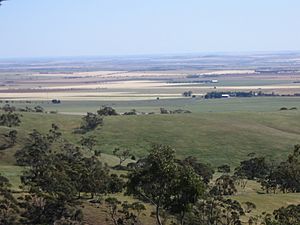Spring Gully Conservation Park facts for kids
Quick facts for kids Spring Gully Conservation ParkSevenhills & Spring Gully, South Australia |
|
|---|---|
|
IUCN Category III (Natural Monument)
|
|

Red Stringybark woodland in Spring Gully CP
|
|
| Nearest town or city | Clare |
| Established | 12 January 1961 |
| Area | 3.96 km2 (1.5 sq mi) |
| Managing authorities | Department for Environment and Water |
| Website | Spring Gully Conservation Park |
| See also | Protected areas of South Australia |
Spring Gully Conservation Park is a special protected area in the Australian state of South Australia. It is located near the towns of Sevenhills and Spring Gully. The park is about 6 kilometers (about 4 miles) south of Clare. It's a great place to explore nature and see unique trees.
Contents
History of the Park
Spring Gully Conservation Park has been protected for many years. It started as a "wildlife reserve" in 1961. More land was added to this reserve in 1966. In 1967, it became the "Spring Gully National Park." Later, in 1972, it was renamed "Spring Gully Conservation Park." This name change helped show its important role in protecting nature. Today, the park covers about 3.96 square kilometers (about 1.5 square miles).
What Makes Spring Gully Special?
This park is home to something very unique. It has the only group of red stringybark trees (Eucalyptus macrorhyncha) in South Australia. These trees are like a living link to a time when the area was much wetter. The closest other groups of these trees are far away in New South Wales and Victoria.
Amazing Views
From the park, you can see amazing views over the plains to the west. Many local people enjoy visiting Spring Gully for picnics. The park is located on a western ridge of the northern Mount Lofty Ranges.
Plants and Animals
The upper slopes of the park have an open forest. This forest is mostly made up of the special red stringybark trees. In more open areas, you can find "blackboys" (Xanthorrhoea sp.), which are also known as grass trees.
The park is also home to different animals. You might spot western grey kangaroos and euros (a type of kangaroo) living in the ranges here.
Endangered Orchid
One very special plant in the park is the white beauty spider orchid (Caladenia argocalla). This beautiful orchid is listed as "endangered." This means it is at high risk of disappearing forever. Protecting the park helps keep this rare flower safe.
Challenges for the Trees
The red stringybark trees in the park have faced some tough times. From mid-2007 to early 2008, there was a very dry period. Then, in March 2008, there was a record heatwave. Thousands of these special trees died because of these conditions.
Some trees survived, but their leaves died. They later grew new shoots from their trunks. However, many of these new shoots also died by mid-2009. In November 2009, a lightning strike caused a bushfire in part of the park. This fire added even more stress to the trees that were already struggling.
Things to Do
A part of the famous Riesling Trail passes along the northern side of Spring Gully Conservation Park. This section is known as the Spring Gully Loop. The Riesling Trail is popular for walking and cycling.
How the Park is Protected
Spring Gully Conservation Park is classified as an IUCN Category III protected area. This means it is protected mainly for its natural features. In 1980, it was also listed on the now-closed Register of the National Estate. This showed its importance to Australia's natural heritage.



